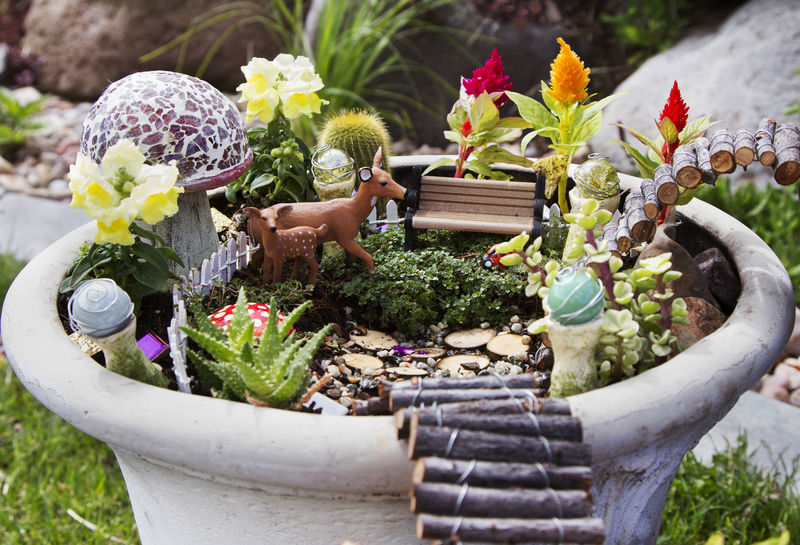Achieving Orchid Success: A Caregiver's Handbook
Posted on 16/05/2025
Achieving Orchid Success: A Caregiver's Handbook
Are you dreaming of vibrant, flourishing orchids gracing your home with their exquisite blooms? Orchids, with their mystical beauty and diversity, can be a joy to grow when equipped with the right techniques and insights. This orchid care handbook will guide caregivers -- from beginners to experienced enthusiasts -- on their journey to orchid mastery.
Understanding Orchids: The Foundation of Success
Before delving into orchid care tips, it's essential to understand what makes these plants unique. Orchids belong to one of the largest families of flowering plants, boasting over 25,000 species worldwide. Their adaptations allow them to thrive in various environments -- from lush rainforests to arid deserts -- so their care can differ significantly from common houseplants like pothos or peace lilies.
Common Orchid Varieties for Caregivers
- Phalaenopsis (Moth Orchid): The best beginner choice for its forgiving nature and abundant blooms.
- Cattleya: Known for their vibrant colors and sweet fragrance.
- Dendrobium: Diverse in growth patterns and flower shapes, suitable for moderate experience levels.
- Oncidium (Dancing Lady): Recognized for their distinctive, cascading floral sprays.
Pro Tip: Identify your orchid variety for tailored care and optimal success.

Orchid Habitats: Mimicking Nature In Your Home
Replicating your orchid's natural environment is the foundation of successful orchid care. Most household orchids thrive as epiphytes, growing on trees rather than in soil, which means their roots need air as much as moisture. Understanding this is the secret behind many orchid success stories.
Humidity and Airflow
- Ideal Humidity: Orchids love 40%-60% humidity. Use a humidifier, pebble tray, or regular misting to maintain these levels.
- Ventilation: Good airflow prevents diseases and dries out excess moisture, keeping roots healthy.
Light Needs for Vibrant Blooms
- Phalaenopsis: Prefers bright, indirect sunlight. Avoid southern window full sun -- leaves will scorch.
- Cattleya & Dendrobium: Thrive with more light; east or shaded south/west windows are ideal.
- General Rule: Leaves should be a light, grassy green -- dark leaves often mean insufficient light, while yellowing indicates too much.
Temperature Requirements
Most orchids prefer daytime temperatures between 65?F-80?F (18?C-27?C) and nighttime temperatures dropping 10-15?F (6-8?C) lower. This difference can trigger flower spikes, so keep your plant near a window where temperature changes are more pronounced.
Watering Wisdom: How and When to Water Orchids
Overwatering is the number one killer of orchids! Unlike many houseplants, their roots must breathe. Here's how to get watering right and nurture your orchid plants to healthy growth.
Signs Your Orchid Needs Water
- Potting mix is dry to the touch and the container feels light.
- Roots appear silvery gray rather than green.
- Leaves begin to (slightly) wrinkle or lose turgidity.
How to Water for Orchid Success
- Water thoroughly: Drench the potting medium, then allow excess water to fully drain out. Never let your orchid sit in standing water.
- Frequency: Water only when nearly dry. Typically, this is every 5-10 days, but it depends on your orchid type, pot size, and environment.
- Morning is best: Watering early gives foliage time to dry, reducing the risk of fungal problems.
Choosing the Right Orchid Potting Mix and Containers
As epiphytes, most orchids need a porous, chunky potting medium and a well-ventilated container. The right combination promotes strong roots -- the backbone of your plant's health.
Best Potting Mix Ingredients
- Bark chips: Most common, they provide good drainage and airflow for roots.
- Sphagnum moss: Retains more moisture; best for seedlings or recovering orchids.
- Perlite or charcoal: Lightens the mix, prevents compaction and absorbs toxins.
Container Choice: Opt for clear, slotted orchid pots to monitor root health and ensure ventilation. Avoid standard houseplant pots with just one small drainage hole.
The Key to Orchid Nutrition: Feeding for Optimal Health
Orchids do not grow in rich soil; they rely on rainwater for nutrients in nature. To replicate this, feed with a diluted orchid fertilizer (20-20-20) at quarter to half-strength every 2-3 weeks when actively growing. Avoid overfeeding, which can cause root burn and prevent orchid blooming success.
- Balanced Fertilizer: "Weakly, weekly" is the mantra -- less is more.
- Flush Potting Mix: Every month, water thoroughly to wash away fertilizer salts.
Repotting for Longevity and Success
Repotting refreshes your orchid's environment and prevents root rot. Typically, repot every 1-2 years, or sooner if the medium breaks down or the plant is outgrowing its container.
Signs It's Time to Repot
- Potting medium looks mushy, compacted, or smells musty.
- Roots are circling tightly or growing out of the pot.
- Plant looks top-heavy or the pot won't stay upright.
How to Repot an Orchid
- Gently remove your orchid from its old pot, loosen and trim off dead roots.
- Place in fresh, moistened orchid mix at the same depth as before.
- Stabilize the plant and let it acclimate in indirect light, withholding fertilizer for 3-4 weeks.
Orchid Bloom Cycles: Encouraging Reblooming
One of the keys to orchid success is understanding how to encourage repeat blooms. Many owners toss their plant after the first fall of flowers, not realizing the orchid can rebloom for years with patience and proper techniques.
- Allow a rest period: Orchids may rest for several months with little visible growth. This is normal!
- Light and temperature triggers: A seasonal drop in night temperature can initiate new spikes, especially in fall/winter.
- Care for faded spikes: For Phalaenopsis, you may trim just above a node on the flower spike to encourage side shoots.
Remember, patience is indispensable. Healthy, happy orchids are far more likely to rebloom and thrive.
Troubleshooting Common Orchid Problems
Even experienced orchid caregivers face challenges. Here's how to identify and address some frequent issues:
Yellow Leaves
- Possible Causes: Overwatering, root rot, or direct sunburn.
- Solution: Allow roots to dry, adjust lighting, trim rotted roots.
Wilted or Wrinkled Leaves
- Possible Causes: Underwatering, root damage, or pests.
- Solution: Inspect roots, water appropriately, treat pests if found.
No Blooms
- Possible Causes: Insufficient light, lack of temperature dip, or overfeeding nitrogen.
- Solution: Move to a brighter spot, induce cooler nights, switch to a bloom-boosting fertilizer.
Pest & Disease Management
- Common Pests: Scale, aphids, spider mites, and mealybugs.
- Remedies: Swipe gently with an alcohol-dipped cotton swab, use insecticidal soap, and increase airflow.
- Fungal Issues: Black spots, root/stem rot.
- Prevention: Avoid contact with stagnant water, provide air movement, and sterilize cutting tools.
Expert Orchid Caregiver Tips
- Keep a care log: Track watering, feeding, and blooming periods for each orchid.
- Rotate your plants: Ensures even light exposure and reduces pest problems.
- Group orchids together: Creates localized humidity to support all your plants.
- Learn patience: Orchid success is a process -- don't rush nature!

Frequently Asked Questions About Orchid Success
1. How often do orchids bloom?
Most Phalaenopsis orchids bloom once a year for several months, but with proper care, some can rebloom twice. Each species and hybrid follows its own pattern.
2. Should I cut the flower spike after blooming?
For Phalaenopsis, trim above a visible node; for cattleya, dendrobium, and others, cut the spike off when it turns brown and dry.
3. Can indoor orchids go outdoors?
Yes, but gradually acclimate them to light and ensure temperatures do not drop below 50?F (10?C). Watch for pests during the outdoor season.
4. My orchid has exposed roots--should I bury them?
No, those "air roots" help the plant breathe. Leave healthy roots exposed for the best orchid health.
Conclusion: Your Pathway to Orchid Mastery
Success with orchids is absolutely within reach! By understanding their unique needs, optimizing your home environment, and staying patient, you can foster beautifully blooming orchids year after year. This caregiver's handbook for orchid success has equipped you with the comprehensive guidance to overcome challenges and celebrate every new spike and flower.
Let your orchid journey begin today -- your window sill will soon be awash in breathtaking color!

